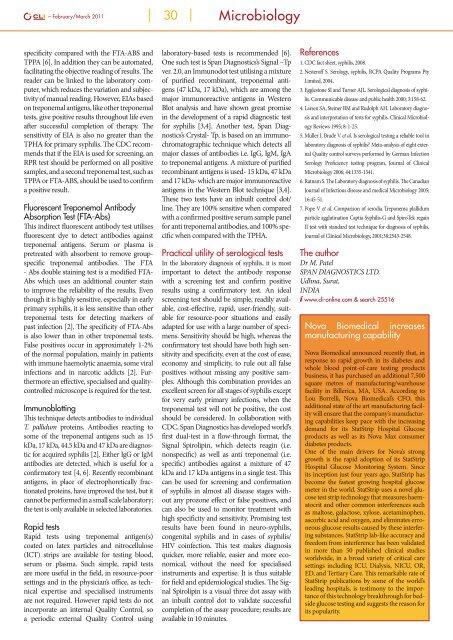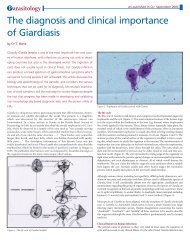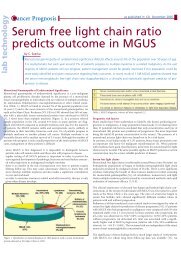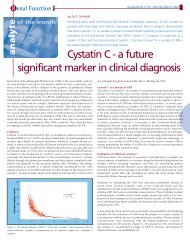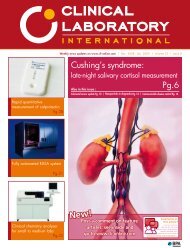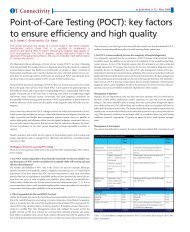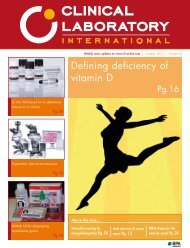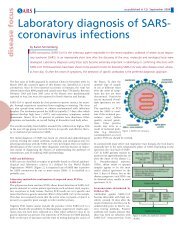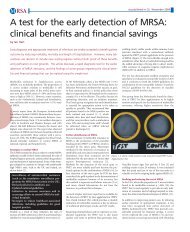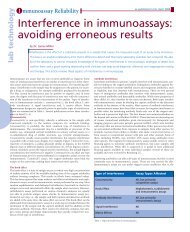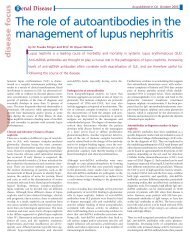Screening for cancer: are biomarkers of value?
Screening for cancer: are biomarkers of value?
Screening for cancer: are biomarkers of value?
You also want an ePaper? Increase the reach of your titles
YUMPU automatically turns print PDFs into web optimized ePapers that Google loves.
– February/March 2011 30 Microbiology<br />
specificity comp<strong>are</strong>d with the FTA-ABS and<br />
TPPA [6]. In addition they can be automated,<br />
facilitating the objective reading <strong>of</strong> results. The<br />
reader can be linked to the laboratory computer,<br />
which reduces the variation and subjectivity<br />
<strong>of</strong> manual reading. However, EIAs based<br />
on treponemal antigens, like other treponemal<br />
tests, give positive results throughout life even<br />
after successful completion <strong>of</strong> therapy. The<br />
sensitivity <strong>of</strong> EIA is also no greater than the<br />
TPHA <strong>for</strong> primary syphilis. The CDC recommends<br />
that if the EIA is used <strong>for</strong> screening, an<br />
RPR test should be per<strong>for</strong>med on all positive<br />
samples, and a second treponemal test, such as<br />
TPPA or FTA-ABS, should be used to confirm<br />
a positive result.<br />
Fluorescent Treponemal Antibody<br />
Absorption Test (FTA-Abs)<br />
This indirect fluorescent antibody test utilises<br />
fluorescent dye to detect antibodies against<br />
treponemal antigens. Serum or plasma is<br />
pretreated with absorbent to remove groupspecific<br />
treponemal antibodies. The FTA<br />
- Abs double staining test is a modified FTA-<br />
Abs which uses an additional counter stain<br />
to improve the reliability <strong>of</strong> the results. Even<br />
though it is highly sensitive, especially in early<br />
primary syphilis, it is less sensitive than other<br />
treponemal tests <strong>for</strong> detecting markers <strong>of</strong><br />
past infection [2]. The specificity <strong>of</strong> FTA-Abs<br />
is also lower than in other treponemal tests.<br />
False positives occur in approximately 1-2%<br />
<strong>of</strong> the normal population, mainly in patients<br />
with immune haemolytic anaemia, some viral<br />
infections and in narcotic addicts [2]. Furthermore<br />
an effective, specialised and qualitycontrolled<br />
microscope is required <strong>for</strong> the test.<br />
Immunoblotting<br />
This technique detects antibodies to individual<br />
T. pallidum proteins. Antibodies reacting to<br />
some <strong>of</strong> the treponemal antigens such as 15<br />
kDa, 17 kDa, 44.5 kDa and 47 kDa <strong>are</strong> diagnostic<br />
<strong>for</strong> acquired syphilis [2]. Either IgG or IgM<br />
antibodies <strong>are</strong> detected, which is useful <strong>for</strong> a<br />
confirmatory test [4, 6]. Recently recombinant<br />
antigens, in place <strong>of</strong> electrophoretically fractionated<br />
proteins, have improved the test, but it<br />
cannot be per<strong>for</strong>med in a small scale laboratory;<br />
the test is only available in selected laboratories.<br />
Rapid tests<br />
Rapid tests using treponemal antigen(s)<br />
coated on latex particles and nitrocellulose<br />
(ICT) strips <strong>are</strong> available <strong>for</strong> testing blood,<br />
serum or plasma. Such simple, rapid tests<br />
<strong>are</strong> more useful in the field, in resource-poor<br />
settings and in the physician’s <strong>of</strong>fice, as technical<br />
expertise and specialised instruments<br />
<strong>are</strong> not required. However rapid tests do not<br />
incorporate an internal Quality Control, so<br />
a periodic external Quality Control using<br />
laboratory-based tests is recommended [6].<br />
One such test is Span Diagnostics’s Signal –Tp<br />
ver. 2.0, an Immunodot test utilising a mixture<br />
<strong>of</strong> purified recombinant, treponemal antigens<br />
(47 kDa, 17 kDa), which <strong>are</strong> among the<br />
major immunoreactive antigens in Western<br />
Blot analysis and have shown great promise<br />
in the development <strong>of</strong> a rapid diagnostic test<br />
<strong>for</strong> syphilis [3,4]. Another test, Span Diagnostics’s<br />
Crystal- Tp, is based on an immunochromatographic<br />
technique which detects all<br />
major classes <strong>of</strong> antibodies i.e. IgG, IgM, IgA<br />
to treponemal antigens. A mixture <strong>of</strong> purified<br />
recombinant antigens is used- 15 kDa, 47 kDa<br />
and 17 kDa- which <strong>are</strong> major immunoreactive<br />
antigens in the Western Blot technique [3,4].<br />
These two tests have an inbuilt control dot/<br />
line. They <strong>are</strong> 100% sensitive when comp<strong>are</strong>d<br />
with a confirmed positive serum sample panel<br />
<strong>for</strong> anti treponemal antibodies, and 100% specific<br />
when comp<strong>are</strong>d with the TPHA.<br />
Practical utility <strong>of</strong> serological tests<br />
In the laboratory diagnosis <strong>of</strong> syphilis, it is most<br />
important to detect the antibody response<br />
with a screening test and confirm positive<br />
results using a confirmatory test. An ideal<br />
screening test should be simple, readily available,<br />
cost-effective, rapid, user-friendly, suitable<br />
<strong>for</strong> resource-poor situations and easily<br />
adapted <strong>for</strong> use with a large number <strong>of</strong> specimens.<br />
Sensitivity should be high, whereas the<br />
confirmatory test should have both high sensitivity<br />
and specificity, even at the cost <strong>of</strong> ease,<br />
economy and simplicity, to rule out all false<br />
positives without missing any positive samples.<br />
Although this combination provides an<br />
excellent screen <strong>for</strong> all stages <strong>of</strong> syphilis except<br />
<strong>for</strong> very early primary infections, when the<br />
treponemal test will not be positive, the cost<br />
should be considered. In collaboration with<br />
CDC, Span Diagnostics has developed world’s<br />
first dual-test in a flow-through <strong>for</strong>mat, the<br />
Signal Spirolipin, which detects reagin (i.e.<br />
nonspecific) as well as anti treponemal (i.e.<br />
specific) antibodies against a mixture <strong>of</strong> 47<br />
kDa and 17 kDa antigens in a single test. This<br />
can be used <strong>for</strong> screening and confirmation<br />
<strong>of</strong> syphilis in almost all disease stages without<br />
any prozone effect or false positives, and<br />
can also be used to monitor treatment with<br />
high specificity and sensitivity. Promising test<br />
results have been found in neuro-syphilis,<br />
congenital syphilis and in cases <strong>of</strong> syphilis/<br />
HIV coinfection. This test makes diagnosis<br />
quicker, more reliable, easier and more economical,<br />
without the need <strong>for</strong> specialised<br />
instruments and expertise. It is thus suitable<br />
<strong>for</strong> field and epidemiological studies. The Signal<br />
Spirolipin is a visual three dot assay with<br />
an inbuilt control dot to validate successful<br />
completion <strong>of</strong> the assay procedure; results <strong>are</strong><br />
available in 10 minutes.<br />
References<br />
1. CDC fact sheet, syphilis, 2008.<br />
2. Nester<strong>of</strong>f S. Serology, syphilis, RCPA Quality Programs Pty<br />
Limited, 2004.<br />
3. Egglestone SI and Turner AJL. Serological diagnosis <strong>of</strong> syphilis.<br />
Communicable disease and public health 2000; 3:158-62.<br />
4. Larsen SA, Steiner BM and Rudolph AH. Laboratory diagnosis<br />
and interpretation <strong>of</strong> tests <strong>for</strong> syphilis. Clinical Microbiology<br />
Reviews 1995; 8: 1-25.<br />
5. Muller I, Brade V et al. Is serological testing a reliable tool in<br />
laboratory diagnosis <strong>of</strong> syphilis? Meta-analysis <strong>of</strong> eight external<br />
Quality control surveys per<strong>for</strong>med by German Infection<br />
Serology Pr<strong>of</strong>iciency testing program, Journal <strong>of</strong> Clinical<br />
Microbiology 2006; 44:1335-1341.<br />
6. Ratnam S. The Laboratory diagnosis <strong>of</strong> syphilis. The Canadian<br />
Journal <strong>of</strong> Infectious disease and medical Microbiology 2005;<br />
16:45-51.<br />
7. Pope V et al. Comparison <strong>of</strong> serodia Treponema plallidum<br />
particle agglutination Captia Syphilis-G and SpiroTek regain<br />
II test with standard test technique <strong>for</strong> diagnosis <strong>of</strong> syphilis,<br />
Journal <strong>of</strong> Clinical Microbiology, 2001;38:2543-2548.<br />
The author<br />
Dr M. Patel<br />
SPAN DIAGNOSTICS LTD.<br />
Udhna, Surat,<br />
INDIA<br />
www.cli-online.com & search 25516<br />
Nova Biomedical increases<br />
manufacturing capability<br />
Nova Biomedical announced recently that, in<br />
response to rapid growth in its diabetes and<br />
whole blood point-<strong>of</strong>-c<strong>are</strong> testing products<br />
business, it has purchased an additional 7,500<br />
squ<strong>are</strong> metres <strong>of</strong> manufacturing/w<strong>are</strong>house<br />
facility in Billerica, MA, USA. According to<br />
Lou Borrelli, Nova Biomedical’s CFO, this<br />
additional state <strong>of</strong> the art manufacturing facility<br />
will ensure that the company’s manufacturing<br />
capabilities keep pace with the increasing<br />
demand <strong>for</strong> its StatStrip Hospital Glucose<br />
products as well as its Nova Max consumer<br />
diabetes products.<br />
One <strong>of</strong> the main drivers <strong>for</strong> Nova’s strong<br />
growth is the rapid adoption <strong>of</strong> its StatStrip<br />
Hospital Glucose Monitoring System. Since<br />
its inception just four years ago, StatStrip has<br />
become the fastest growing hospital glucose<br />
meter in the world. StatStrip uses a novel glucose<br />
test strip technology that measures haematocrit<br />
and other common interferences such<br />
as maltose, galactose, xylose, acetaminophen,<br />
ascorbic acid and oxygen, and eliminates erroneous<br />
glucose results caused by these interfering<br />
substances. StatStrip lab-like accuracy and<br />
freedom from interference has been validated<br />
in more than 50 published clinical studies<br />
worldwide, in a broad variety <strong>of</strong> critical c<strong>are</strong><br />
settings including ICU, Dialysis, NICU, OR,<br />
ED, and Tertiary C<strong>are</strong>. This remarkable rate <strong>of</strong><br />
StatStrip publications by some <strong>of</strong> the world’s<br />
leading hospitals, is testimony to the importance<br />
<strong>of</strong> this technology breakthrough <strong>for</strong> bedside<br />
glucose testing and suggests the reason <strong>for</strong><br />
its popularity.


